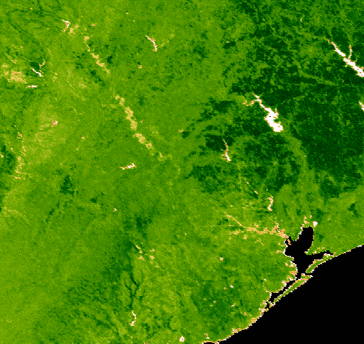

A new perspective on Texas phenology
August 25, 2020
As Texans, we are all too familiar with dramatic shifts in weather throughout the year—from impossibly cold winters to unbearably hot summers. Along with temperature swings, you probably notice changes occurring in the plants around you. Phenology is the study of this pattern of green-up and die-back, or the reoccurring life cycle stages of plants such as leafing, flowering, fruiting, and the maturation of crops. This cycle is responsible for the grey, leafless trees in January, vibrant bluebonnets in the spring, and the struggling St. Augustine in your front yard come August. While we observe these changes from the ground-level, what does a year of vegetation growth look like from space?
The National Aeronautics and Space Administration (NASA) operates satellites that are able to photograph the entire Earth’s surface every 1-2 days. These images are commonly used to assess and monitor vegetation over very large areas, a task that would be extremely difficult using on-the-ground sampling techniques.
In our latest featured map, we took satellite imagery collected throughout 2019 and stitched them together in an animation to illustrate the phenological changes of vegetation across Texas. At a glance, you can easily see the gradient of greenness that manifests across the state. The dense forests of the Piney Woods of East Texas transition into sparsely vegetated prairies and Hill Country landscapes, eventually terminating in the Chihuahuan Desert of far West Texas.
It is interesting to note how the regions across the state change over the course of a year. The yearly green-up starts around March in the East and pulses outward, eventually reaching the oak and juniper forests of the Davis Mountains by the June-July timeframe. Evidence of irrigated cropland can be seen in the panhandle, which remain green year-round while the surrounding native areas die back in the winter months. Forage production in the Brazos River valley has its own unique signature with empty fields in winter that green up in April and May when the first cutting of hay usually occurs.


Earth observation satellite imagery provides us with yet another tool to assess the quality of vegetation and monitor changes in an area over time. While this map is purely for illustrative purposes, NRI has put these techniques to work in several projects focused on natural resource conservation.
--
The Texas A&M Natural Resources Institute grants permission for authors, readers and third parties to reproduce and republish materials from its blogs, publications and online products through permission requests to NRI Communications at nri@tamu.edu. This includes the use of figures, maps, photography and video media. If you have questions about permissions, please contact Brittany Wegner. Texas A&M NRI operates as a unit of the College of Agriculture and Life Sciences at Texas A&M University. Texas A&M AgriLife Research, the Texas A&M AgriLife Extension Service.
Learn More
Land & water trends
Informing private and public decision-makers about the status and trends of our state’s working lands












